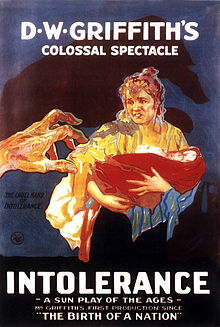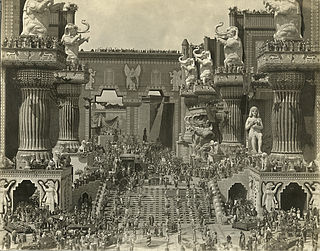Intolerance (film)
| Intolerance: Love's Struggle Through the Ages | |
|---|---|
 Theatrical poster | |
| Directed by | D. W. Griffith |
| Written by | D.W. Griffith Hettie Grey Baker Tod Browning Anita Loos Mary H. O'Connor Walt Whitman Frank E. Woods |
| Produced by | D. W. Griffith |
| Starring | Mae Marsh Robert Harron Constance Talmadge Lillian Gish Gino Corrado Douglas Fairbanks Madame Sul-Te-Wan King Vidor |
| Cinematography | Billy Bitzer |
| Edited by | D. W. Griffith James Smith Rose Smith |
| Music by | Carl Davis |
| Distributed by | Triangle Distributing Corporation |
Release date | September 5 1916 (U.S. release) |
Running time | 163 min. / Spain:123 min. / UK:178 min. (2000 video release) / USA:197 min. |
| Country | Template:FilmUS |
| Languages | Silent film English intertitles |
| Budget | $385,907[1] |
Intolerance: Love's Struggle Through the Ages, a silent film directed by D. W. Griffith in 1916, is considered one of the great masterpieces of the Silent Era.[2] It has also been called "the only film fugue".[3][4][5] Professor Theodore Huff, one of the leading film critics of the first half of the twentieth century, stated that it was the only motion picture worthy of taking its place alongside Beethoven's Fifth Symphony, the masterpieces of Michelangelo, etc. as a separate work of art.[3] It was made in response to critics who protested against Griffith's previous film, The Birth of a Nation, for its overt racist content, characterizing racism as people's "intolerance" of other people's views.
Background
 |
Intolerance was a colossal undertaking filled with monumental sets, lavish period costumes, and more than 3,000 extras. The film consisted of four distinct but parallel stories that demonstrated mankind's intolerance during four different ages in world history. The timeline covered approximately 2,500 years, beginning with:
- The "Babylonian" period (539 B.C.) depicts the fall of Babylon as a result of intolerance arising from a conflict between devotees of different Babylonian gods.
- The "Judean" era (circa 27 A.D.) recounts how intolerance led to the crucifixion of Jesus.
- The French Renaissance (1572) tells of the failure of the Edict of Toleration that led to the St. Bartholomew's Day Massacre.
- Modern America (1914) demonstrates how crime, moral puritanism, and conflicts between ruthless capitalists and striking workers helped ruin the lives of Americans.
Griffith began shooting the film with the Modern Story (originally titled "The Mother and the Law"), whose planning predated Birth of a Nation, then greatly expanded it to include the other three parallel stories under the theme of intolerance. These stories are not told separately. Instead the film constantly cuts between them, setting up moral and psychological connections among the different stories. As the four stories progress toward their climaxes, the cuts become more rapid. Breaks between the differing time-periods are marked by the symbolic image of a mother rocking a cradle, representing the passing of generations.
One of the unusual characteristics of the film is that most of the characters don't have names. Griffith wished them to be emblematic of human types. Thus, the central female character in the modern story is called The Dear One. Her young husband is called The Boy, and the leader of the local Mafia is called The Musketeer of the Slums. Critics and film theorists indicate these names show Griffith's sentimentalism, which was already hinted at in The Birth of a Nation, with names such as The Little Colonel.
Actual costs to produce Intolerance are unknown, but best estimates are close to $2 million (approximately $41 million in 2008 dollars), an astronomical sum in 1916. The movie was by far the most expensive made at that point. When the movie became a flop at the box-office, the burden was so great that Griffith's Triangle Studios went bankrupt.
The film and its unorthodox editing were enormously influential, particularly among European and Soviet filmmakers. Many of the numerous assistant directors Griffith employed in making the film went on to become important and noted Hollywood directors in the subsequent years.
A detailed account of the film’s making is told in William M. Drew's 1986 book titled D.W.Griffith's Intolerance: Its Genesis and Its Vision.[6]

Different existing versions
Although the film itself is now in the public domain, there are currently four major versions of the film in circulation.
- The Killiam Shows Version: This version, taken from a third-generation 16 millimeter print, contains an organ score by Gaylord Carter. Running approx. 176 minutes, this is the version that has been the most widely seen in recent years, and is currently airing on Turner Classic Movies. It has been released on LaserDisc and DVD by Image Entertainment. This is the most complete version currently available on home video.
- The Kino Version: Pieced together by Kino International, this version, taken from better 35 millimeter material, is transferred at a slower frame rate than the Killiam Shows print, resulting in a longer running time of 197 minutes. It contains a synth orchestral score by Joseph Turrin. An alternate "happy ending" to the "Fall of Babylon" sequence, showing the Mountain Girl surviving and re-united with the Rhapsode, is included on the DVD as a supplement. While not as complete as the Killiam Shows Version, this print contains footage not found on any other home video release.
- The Official Thames Silents Restoration: In 1989, this film was given a formal restoration by film preservationists Kevin Brownlow and David Gill. This version, also running 197 minutes, was prepared by Thames Television from original 35 millimeter material, and its tones and tints restored per Griffith's original intent. It also has a digitally recorded orchestral score by Carl Davis. It was released briefly on home video in the 1990s, but has never been telecast in the United States. This version is under copyright by the Rohauer Collection, who worked in association with Thames on the restoration.
- The Restored Digital Cinema Version: Restoration conducted by ZZ Productions in collaboration with the Danish Film Institute and Arte France of the version shown on 7 April 1917 at the Theatre Royal, Drury Lane in London. This version runs approx. 177 minutes and premiered 29 August 2007 at the Venice Film Festival and on 4 October on arte.[7]
There are other budget/public domain video and Digital Video Disc versions of this film released by different companies, each with varying degrees of picture quality depending on the source that was used. A majority of these released are of poor picture quality, but even the restored 35 millimeter versions exhibit considerable film damage.
Cameraman Karl Brown remembered a scene with the various members of the Babylonian harem that featured full frontal nudity. He was barred from the set that day, apparently because he was so young. While there are several shots of slaves and harem girls throughout the film (which were shot by another director, without Griffith's involvement) the scene that Brown describes is not in any surviving versions.[8]
Critical reception
The film was shown out of competition at the 1982 Cannes Film Festival.[9]
In 1989, Intolerance was selected for preservation in the United States National Film Registry by the Library of Congress as being "culturally, historically, or aesthetically significant", going in during the first year of voting.
Cast
- Ruth St. Denis is listed by some modern sources as the Solo Dancer in the Babylonian Story, but she denied this in an interview. However, it is generally believed St. Denis and her "Denishawn dancers" appear on the steps of the Babylon set in the great courtyard scene. Ted Shawn also had an uncredited role[12].
See also
References
- ^ Internet Movie Database. Intolerance, Box office/business. Retrieved on August 1, 2009.
- ^ Tim Dirks, "Intolerance (1916)", The Best Films of All Time - A Primer of Cinematic History, on line.
- ^ a b Franklin, Joe: Classics of the Silent Screen, The Citadel Press, New York, NY, 1959
- ^ Zito, Stephen F., American Film Institute and Library of Congress, Cinema Club 9 Program Notes, Post Newsweek Stations, Washington, DC, Nov., 1971
- ^ Huff, Theodore quoted in Classics of the Silent Screen, The Citadel Press, New York, NY 1959
- ^ William M. Drew, D.W.Griffith's Intolerance: Its Genesis and Its Vision, Jefferson, NJ, McFarland & Company (1986); (2001). ISBN 0786412097
- ^ La Biennale di Venezia
- ^ Internet Movie Database - Trivia
- ^ "Festival de Cannes: Intolerance". festival-cannes.com. Retrieved 2009-06-14.
- ^ a b c d e f MovieTome
- ^ Internet Movie Database - Full credits
- ^ "Ted Shawn", IMDB
